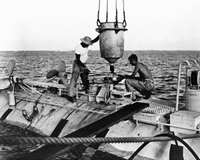
The diving submersible vessel Trieste descends to the floor of the Marianas Trench, the deepest known place on the planet.
The Trieste, a bathyscaph, was designed by Swiss scientist Auguste Piccard and built in Naples, Italy, as a deep-diving research vessel. After proving its mettle in the Mediterranean, the Trieste was purchased by the U.S. Navy and shipped to San Diego. Its dive into the Challenger Deep, the deepest part of the trench, was made, according to a U.S. Navy press release, “to demonstrate that the United States possesses the capability for manned exploration of the sea down to the deepest part of its floor.” The vessel was equipped with air tanks that could be flooded, like a submarine’s, to help it dive. Additionally, it was weighted down with nine tons of iron shot. Trieste descended at a rate of three feet per second to a depth of 27,000 feet, after which its descent rate was halved.

It took U.S. Navy lieutenant Donald Walsh and Jacques Piccard (son of Trieste’s designer) four hours and forty-eight minutes to make the descent to a depth of 35,810 feet, roughly seven miles. The pressure there is nearly 17,000 pounds per square inch. Although an outer Plexiglas window cracked during the descent, Trieste handled the dive like a champ. After sitting on the bottom for twenty minutes, eating candy bars and shining a light that illuminated a shrimplike creature outside, Walsh and Piccard pumped out two tons of iron shot and began their ascent. The trip home was faster—three hours and seventeen minutes to the surface.
Trieste was sent to the Atlantic Ocean in 1963 to search for the nuclear attack submarine USS Thresher, which was lost with all hands during a deep-diving exercise. Upon the bathyscaph’s return, it was retired to the U.S. Navy Museum in Washington.—TL